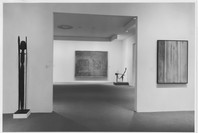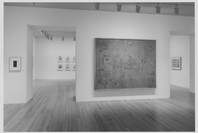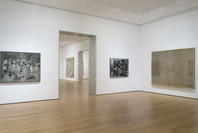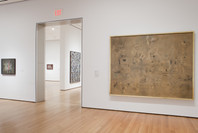"This is a world," Gorky said of Summation. But it is an ambiguous world. The plant– and animal–like forms that appear to blossom, flop, poke, and tickle each other defy identification, even while their forms are crisp and clear. Gorky's interest in the Surrealist practice of spontaneous and unplanned "automatic" drawing freed and mobilized his line, allowing him to create what Surrealist leader André Breton called "hybrids," or linear units with multiple metaphoric meanings.
“There is my world,” Gorky said of this composition filled with forms that appear to blossom, flop, poke, and tickle each other. Although his paintings and this work on paper (his largest) have an improvisatory spirit, they are closely based on preliminary drawings. Gorky’s interest in the Surrealist practice of spontaneous, unplanned “automatic” drawing freed and mobilized his line, allowing him to create what Surrealist leader André Breton called “hybrids”— abstract forms based on close observations of the natural world.
Gallery label from 2011.
Summation is filled with pseudobiological forms that appear to blossom, flop, poke, and tickle each other but otherwise defy identification. “There is my world,” Gorky said of this work, his largest on paper. Drawing played a significant role in the artist’s creative process. Although his paintings and this drawing have an improvisatory spirit, they are closely based on preliminary studies on paper. _Summation_’s paper support was originally white; its current tan color is the result of exposure to light over the years.
Gallery label from Abstract Expressionist New York, October 3, 2010-April 25, 2011.
The sheer grandness of Summation, its alloy of precision and imposing scale, associates it with the classical masters of the past. Quite unclassical, though, is the drawing's nervous, extraordinarily sensuous bonding of sexual or visceral images and references to animals and plants. "This is a world," Gorky said of Summation, but it is a world ambiguously placed—a nature felt in the flesh. Some of its creatures have orifices, joints, and limbs, while others seem to be such body parts, or else internal organs. They blossom or flop, poke or rub or tickle each other, pile up or scurry off in a flock, defying identification even while their forms are definite and clear.
Surrealist automatism had freed Gorky's line, reinforcing its mobility. It is this mobility that allows the line to form what the Surrealist leader André Breton called "hybrids"—units with multiple metaphoric meanings. Separate yet related, clusters of incident form a structure both episodic and unified: the work is conceived not as a whole made up of parts but of parts that together make up a whole. We easily read (if not quite decipher) the various motifs, and by recognizing the formal and familial analogies among them, and the soft continuity of the shading around them, we also read them as one single, richly detailed image.
Publication excerpt from The Museum of Modern Art, MoMA Highlights, New York: The Museum of Modern Art, revised 2004, originally published 1999, p. 188.






